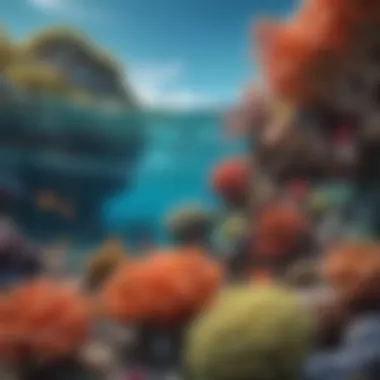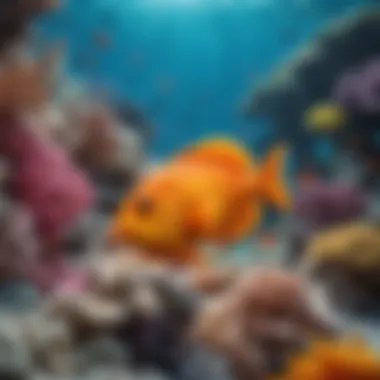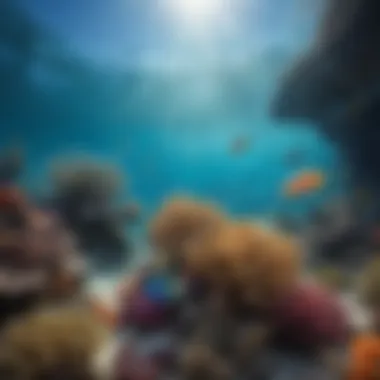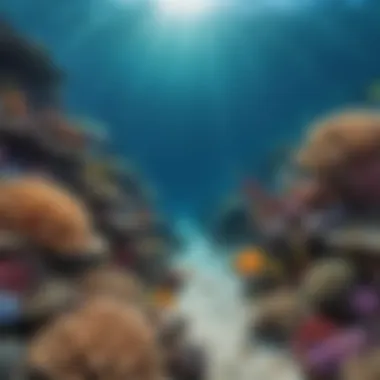Discovering the Diverse Marine Life of the Great Barrier Reef


Intro
The Great Barrier Reef stands not only as a natural wonder but as a crucial ecosystem teeming with diverse life forms. Stretching over 2,300 kilometers along the northeastern coast of Australia, this marine paradise is the world's largest coral reef system. It's recognized for its stunning beauty and intricate marine life, drawing enthusiasts and scientists alike. The significance of this biodiverse environment cannot be overstated – it plays a vital role in maintaining ecological balance and offers insights into the health of our oceans.
As we embark on this exploration, we will uncover the remarkable species that inhabit the reef, from the vibrant clownfish to the majestic sea turtles. These creatures are not merely residents of the reef; they participate in an elaborate web of life, interacting and relying on each other in ways that often go unnoticed.
We will also delve into the ongoing conservation efforts aimed at preserving this delicate ecosystem. With rising sea temperatures and human impact, the reef faces unprecedented challenges. Hence, understanding the complexities of life within the reef not only enriches our appreciation but also sheds light on urgent conservation strategies that are essential for its survival.
This experience will be much like taking a deep dive into a world that is intricate and fragile, where every organism has its part to play. By the end of this article, readers will gain a comprehensive overview of the Great Barrier Reef’s sea life, including its species diversity, ecological relationships, and the wider implications concerning conservation issues.
Let’s take a closer look at the vibrant life that thrives beneath the waves.
Prelims to the Great Barrier Reef
The Great Barrier Reef is not just another stretch of ocean; it’s a treasure trove of marine biodiversity nestled off the coast of Queensland, Australia. Home to thousands of species, ranging from the minuscule to the magnificent, this underwater paradise is crucial for maintaining ecological balance. In this section, we’ll shed light on the significance of this marine wonder, taking a closer look at its geography and the historical narrative that has shaped this remarkable ecosystem.
Geographic Overview
Spanning over 2,300 kilometers, the reef stretches from the northern tip of Queensland downwards, creating a vibrant tapestry of life that draws tourists, scientists, and marine enthusiasts alike. The area comprises approximately 900 islands and thousands of coral reefs, each with its unique habitat.
The Great Barrier Reef's geographic diversity means that you can find everything from shallow lagoons to deep-sea trenches. These varied environments support a wide range of species, ensuring that each region contributes uniquely to the reef’s overall health.
Water quality, temperature, and light availability also play pivotal roles here. Healthy coral thrives in clean, warm waters, and the interplay of these factors leads to the stunning colors and shapes that we often associate with it. The reef acts like a natural barrier, protecting the coast from storms and erosion while providing a safe haven for many marine creatures.
Historical Significance
The history of the Great Barrier Reef isn’t just a tale of nature; it intertwines with human culture, exploration, and conservation. Indigenous Australians, particularly the Aboriginal and Torres Strait Islander peoples, have inhabited these coastal regions for thousands of years, relying on its resources for sustenance and cultural practices. These communities have a profound understanding of the reef, which they call home. Their traditional ecological knowledge is crucial for conservation efforts today.
In the 18th century, European explorers like Captain James Cook brought global attention to the reef, marking the beginning of a complex relationship between humans and this ecosystem. The advent of the tourism industry in the 20th century brought with it both benefits and challenges. While tourism has catalyzed economic growth, it also raised concerns about environmental sustainability, pushing for increased conservation efforts.
"The Great Barrier Reef is not only a testament to marine biodiversity, but also a living canvas reflecting our history, our culture, and our responsibility to protect our natural heritage."
As conservation efforts continue to evolve, understanding the historical context of the Great Barrier Reef plays a vital role in shaping future initiatives aimed at preservation and protection. Acknowledging both its geographical features and historical importance gives us a deeper appreciation of why this natural wonder must be cherished and safeguarded.
Biodiversity in the Great Barrier Reef
The Great Barrier Reef is often whispered about with a sense of awe and fascination amongst biologists and environmental enthusiasts alike. It is not just a beautiful stretch of water; it is a bustling metropolis of marine life. Biodiversity plays a crucial role here, serving as the backbone of this vibrant ecosystem. Healthy biodiversity contributes to the resilience of the reef. Every species, no matter how small or seemingly insignificant, has its part to play. For instance, the myriad of coral species provides habitats and protection for countless fish and invertebrates, facilitating a web of life that is complex and interconnected.
Coral Species
Corals are often underestimated for their intricate beauty and significant role in marine ecosystems. The Great Barrier Reef is home to more than 400 species of coral, each with its unique adaptations and contributions. These corals fall broadly into two categories: hard corals, which build the reef structure, and soft corals, which sway gently in the currents. Hard corals, like the Acropora, not only provide shelter but also serve as a foundation for various habitats. On the other hand, soft corals such as sea fans add a dynamic touch to the underwater panorama. Together, they create a stunning underwater architecture that supports diverse marine life.
Fish Diversity


When wandering through this underwater realm, one cannot help but be enchanted by the kaleidoscope of fish. The Great Barrier Reef boasts over 1,500 species of fish, ranging from the flamboyant clownfish, darting amongst anemones, to the formidable barracuda. Each fish species plays a unique role, like the parrotfish, which helps to keep algae growth in check on coral, allowing corals to thrive. The diversity is not merely a feast for the eyes; it is a crucial component of reef health. A balanced fish population signals a thriving ecosystem, with each species contributing to the food web in vital ways.
Invertebrates
Invertebrates might not hog the spotlight like their finned counterparts, but they are essential players in the reef ecosystem. More than 4,000 species of invertebrates, including starfish, sea urchins, and nudibranchs, can be discovered lurking in the crevices of the reef. These creatures perform various roles, like scavenging and nutrient cycling, maintaining the health of the environment. Take, for instance, the sea cucumber, which sifts through the sand and helps aerate the seabed, promoting the growth of plants. Without these low-profile inhabitants, the reef would face an uphill battle.
Marine Mammals and Reptiles
The Great Barrier Reef isn't just home to fish and invertebrates; it also hosts a variety of marine mammals and reptiles. Species like the dugong and various types of sea turtles make their homes in these waters. Dugongs, often referred to as sea cows, graze on seagrass beds, contributing to the overall healthy ecosystem by promoting seagrass growth. Sea turtles, on the other hand, help to control jellyfish populations, preventing these sometimes overwhelming invaders from taking over the reef. Each of these animals tells a story of adaptation and survival, underscoring the delicate balance of life in the reef.
"Biodiversity in the Great Barrier Reef is not just a number; it is a lifeline that ensures the survival of its intricate web of life."
Overall, the intricate biodiversity present in the Great Barrier Reef serves as a critical indicator of the health of this marvel of nature. Protecting each component, from the smallest coral polyp to the largest fish, ensures the ecological balance that this underwater paradise relies upon.
Ecological Interactions
In the Great Barrier Reef, ecological interactions serve as the backbone of its vibrant marine ecosystem. Understanding these interactions is key to appreciating the complex web of life that thrives below the ocean's surface. Each organism within this habitat, from the tiniest zooplankton to the largest marine mammals, plays a significant role in maintaining the balance of the reef system. These relationships not only drive the biological diversity of the reef but also impact its resilience against environmental changes and threats.
Symbiotic Relationships
Symbiosis is a critical aspect of ecological interactions and highlights the interconnectedness within the reef. Two notable examples are the relationships between corals and zooxanthellae, as well as cleaner fish and their hosts.
Coral and Zooxanthellae
The partnership between coral and zooxanthellae is absolutely fascinating. Zooxanthellae are tiny algae that inhabit the tissues of corals, providing vital nutrients to their hosts through the process of photosynthesis. This relationship allows corals to thrive in nutrient-poor waters, which is quite remarkable.
- Key Characteristic: The ability of zooxanthellae to convert sunlight into energy.
- Contribution to the Ecosystem: This unique process supports the coral's growth and structural integrity, which in turn provides habitat and protection for a myriad of marine organisms.
- Advantages: The coral benefits from the sugars produced by the algae, enabling it to build its calcium carbonate skeleton, while the zooxanthellae gain a safe environment from predation.
- Disadvantages: However, if environmental conditions become unfavorable, such as increased water temperatures or pollution, the zooxanthellae may be expelled, leading to coral bleaching and potential death of the coral reefs.
Cleaner Fish and Hosts
Then there’s the relationship between cleaner fish and their hosts. Cleaner fish, like the cleaner wrasse, offer a service of removing parasites and dead skin from larger fish. This benefits both parties; the cleaner fish get food and the host fish enjoy improved health.
- Key Characteristic: The specialized behavior of cleaner fish, which involves a unique dance-like display to attract clients.
- Contribution to the Ecosystem: These interactions enhance not only the health of individual fish but also contribute to the overall biodiversity and stability of reef systems.
- Advantages: Cleaner fish reduce the likelihood of disease within fish populations, which helps maintain healthy marine communities.
- Disadvantages: If cleaner fish populations decline due to overfishing or habitat loss, host fish could face increased health risks, leading to broader ecological implications.
Predator-Prey Dynamics
In addition to symbiotic relationships, predator-prey dynamics paint a vivid picture of life on the reef. These interactions are fundamental to the control of species populations and the overall health of the ecosystem.
Predators will help keep the populations of prey species in check, preventing overcrowding and the depletion of resources. This has a cascading effect throughout the marine food web.
For instance, large predators like sharks and barracudas maintain the balance by preying on smaller fish, thereby allowing other species to flourish. Meanwhile, prey animals often develop fascinating adaptations, from camouflage to speed, allowing them to evade their hunters.
"Each interaction represents a story, a moment in the vibrant narrative of natural selection and survival, showcasing the resilience and fragility of life within the reef."


The intricacies of these relationships highlight the resilience of the reef but also its vulnerability. Changes in the environment, human impact, and climatic shifts challenge this balance, underscoring the need for conservation efforts. Understanding these ecological interactions is imperative for protecting the Great Barrier Reef and ensuring its vibrant life continues to thrive.
Threats to the Reef Ecosystem
The Great Barrier Reef faces numerous challenges, many of which stem from human activity and environmental changes. Understanding these threats is crucial for preserving the unique maritime ecosystem that thrives in this vibrant underwater paradise. The reef is not just a majestic display of natural beauty; it plays a vital role in maintaining biodiversity, supporting numerous species, and providing economic benefits to local communities. Keep in mind that the health of the Reef affects fishing, tourism, and the well-being of the creatures residing in it.
Climate Change
Climate change emerges as a dominant player in the array of threats facing the Great Barrier Reef. The rise in ocean temperatures is causing widespread coral bleaching, a phenomenon where stressed corals expel the symbiotic algae (zooxanthellae) living in their tissues. This not only affects the coral's vibrant colors but also their health, compromising their ability to survive.
- Temperature Shift: As the waters warm, coral systems face an increased risk of death. This, in turn, threatens the myriad marine species that depend on the reef for shelter and food.
- Acidification: The increase in CO2 levels leads to ocean acidification, which inhibits coral growth and structure. A reef that cannot build itself is a reef that ultimately vanishes.
The situation has reached such a critical point that scientists warn of widespread coral loss if the current trajectory persists. As the saying goes, we can't let our planet go south without taking action.
Pollution
Pollution significantly contributes to the degradation of the Great Barrier Reef. Various forms of pollution – from agricultural runoff to plastic waste – have a direct impact on the health of this ecosystem.
- Agricultural Runoff: Fertilizers and pesticides used in farming can wash into the ocean during rainfall, introducing harmful nutrients into the water. This leads to algal blooms that smother corals, inhibiting their growth and reproduction.
- Waste Disposal: Uncontrolled coastal development and sewage discharge further exacerbate pollution levels. The influx of toxins not only damages coral but also the multitude of creatures that inhabit the reef.
"A healthy reef is akin to a well-tended garden; any neglect can lead to destructive overgrowth and chaos."
Overfishing
Overfishing poses a direct threat by disrupting the balance of marine life in the Great Barrier Reef. Unsustainable fishing practices deplete fish populations that are essential for maintaining healthy coral ecosystems. Without these fish, algae can proliferate unchecked, competing with coral for space and resources.
- Bycatch: The incidental capture of non-target species (bycatch) can also lead to population declines in various marine species, further enhancing the instability of the reef ecosystem.
- Ecosystem Imbalance: Larger predators, such as sharks, are often overfished, leading to an imbalance in the food chain that can have cascading effects throughout the ecosystem. If the large players falter, the entire system can collapse.
Ultimately, these threats are intertwined, creating a complicated web of challenges for the Great Barrier Reef. Protecting this natural wonder is not just a local endeavor but a global responsibility that requires significant effort and collaboration. Addressing these threats head-on can be the difference between degradation and restoration, ensuring that future generations can enjoy one of the planet's most extraordinary marine environments.
Conservation Efforts
Conservation efforts are crucial for the longevity and vitality of the Great Barrier Reef. As one of the most complex and biodiverse ecosystems on Earth, protecting this marine wonder is not just an ecological obligation but a necessity for both present and future generations. The reef faces a myriad of challenges, from climate change to pollution, making proactive conservation initiatives essential. Without these efforts, the vibrant marine life that calls the reef home may dwindle, leading to irreversible damage.
Local Conservation Initiatives
Local conservation initiatives play an indispensable role in safeguarding the Great Barrier Reef. Various community-driven programs aim to increase awareness and ensure sustainable practices among residents and visitors alike. For example, the Great Barrier Reef Marine Park Authority supports initiatives like community monitoring programs where local people participate in observing reef health, which not only educates them on the issues but creates a personal stake in the wellbeing of the reef.
Moreover, organizations like the Coral Triangle Initiative work closely with indigenous communities to promote traditional ecological knowledge. This facet of conservation emphasizes the importance of ancient practices that harmonize with the environment, ensuring that modern methods do not overshadow time-tested approaches.
The ongoing battle against marine debris through local beach clean-ups is another effort contributing to environmental conservation. For instance, citizen-led projects often mobilize volunteers to remove plastic waste and other pollutants from shorelines, preventing harmful debris from escalating into the ocean.
Global Environmental Policies


On a broader scale, global environmental policies are beginning to have a significant impact on how the Great Barrier Reef is managed and protected. International agreements, such as the Paris Agreement, have created a framework for countries to work together against climate change, which greatly influences reef health. For instance, lowering greenhouse gas emissions can help mitigate the warming ocean temperatures that are detrimental to coral.
Another vital global initiative is the United Nations Sustainable Development Goals (SDGs), which underline the importance of conserving marine life and ecosystems. These goals encourage nations to adopt effective laws and regulations that specifically address ocean conservation.
Policies aimed at reducing fishing quotas and establishing marine protected areas (MPAs) are also making waves in safeguarding the reef. Such measures limit the impact of human activities, allowing marine species to thrive. By providing direct protection, these policies create safe havens for vulnerable species, enabling recovery and strengthening resilience against environmental stressors.
"The future success of the Great Barrier Reef relies heavily on the synergy between local actions and global policies. Together, they form a robust defense against the threats faced by this irreplaceable ecosystem."
The Future of the Great Barrier Reef
Ignoring the delicate balance of the Great Barrier Reef would be a grave mistake. Its future intertwines with countless aspects of marine life, biodiversity, and environmental health. The coral reef ecosystem serves not only as a cradle for a staggering variety of species, but it also plays a vital role in protecting coastlines from erosion and supporting local economies, particularly in tourism and fishing. If changes aren’t made, we risk losing not just a beautiful landscape, but the intricate web of life that is dependent on it.
Emerging Technologies
One promising avenue to safeguard the reef involves innovative technologies. These advancements are more than just gadgets; they can be game-changers in monitoring, protecting, and restoring marine ecosystems.
- Artificial Intelligence (AI): With AI, researchers can analyze vast amounts of data from the reef, identifying trends and threats more efficiently than ever before. This aids in early detection of coral bleaching events, ensuring timely interventions.
- Drones for Surveillance: Drones now scout areas of the reef that are hard to reach by other means. They can capture stunning images and gather data, helping scientists monitor coral conditions over time.
- Biotechnology: Scientists are working on understanding coral genetics to possibly breed coral species that are more resilient to temperature shifts and disease. These specially bred corals could help repopulate damaged areas, enhancing reef resilience.
"Technology is no longer just a tool; it’s a bridge to the solutions of tomorrow's environmental challenges."
As these technologies evolve and become more accessible, they offer hope for the future of the Great Barrier Reef.
Research and Monitoring
Effective research and monitoring are fundamental in tackling the challenges facing the Great Barrier Reef. Continual efforts in these areas provide essential insights into the health of the reef and guide conservation strategies.
- Community Involvement: Engaging local communities in research initiatives increases awareness and fosters a sense of ownership over the reef. Citizen scientists gather valuable data on species sightings and environmental changes, enhancing larger scientific efforts.
- Partnerships: Collaborations between universities, government agencies, and NGOs are vital. By pooling resources, like funding and expertise, these partnerships can amplify research outcomes and conservation impacts.
- Long-term Studies: Understanding the trends over time requires long-term monitoring. Programs that consistently track reef health indicators, such as coral cover and fish populations, are crucial to assess the success of conservation measures.
Overall, the future of the Great Barrier Reef hinges on the merging of advanced technologies with dedicated research. By monitoring changes, predicting issues, and facilitating effective interventions, collectively we can aim for a future where this magnificent ecosystem not only survives but thrives.
The End and Reflection
In assessing the bountiful wonders of the Great Barrier Reef, it’s clear that this ecosystem is not just a treasure trove of marine life but a vital component of Earth's ecological balance. Every exploration of the reef uncovers a narrative that intertwines the lives of countless species, showcasing breathtaking biodiversity and intricate relationships. Through the lens of this article, we explored how the Great Barrier Reef supports resilient marine populations and serves as a barometer for environmental health.
In summary, understanding the dynamics at play within this underwater realm helps us recognize the broader implications of its wellbeing. Not only is the reef home to various fishes, corals, and invertebrates, but it also plays an integral role in carbon sequestration, coastal protection, and tourism. Thus, the preservation of the reef is paramount, not just for those who enjoy its beauty but for the global community.
To reflect on the importance of conservation, one might think of the reef as a living library, with each species representing a story waiting to be told. It stands against the backdrop of climate change, pollution, and overfishing, emphasizing the need for proactivity in safeguarding this unique environment. Through understanding and appreciation, we can rally for organized conservation efforts, ensuring that future generations inherit a thriving Great Barrier Reef.
Summary of Key Points
- The Great Barrier Reef is a complex and biodiverse ecosystem crucial for both marine life and human activity.
- It promotes ecological balance through interactions among various species, from coral polyps to larger marine mammals.
- Threats such as climate change, pollution, and overfishing endanger this delicate ecosystem, demanding immediate action.
- Local and global conservation efforts are essential to sustain the biodiversity and health of the reef.
- Each visitor and researcher contribute to the collective responsibility of protecting this natural gem.
Call to Action for Conservation
As we delve into these realities, it becomes evident that each of us holds a piece of the puzzle in preserving the Great Barrier Reef. Here’s how you can contribute:
- Stay Informed: Knowledge is power. Understanding the challenges the reef faces can inspire advocacy and responsible behavior.
- Reduce Plastic Use: Ocean pollution is a grave concern. Cutting down on plastic waste can have a ripple effect on marine health.
- Support Sustainable Tourism: Engage in eco-friendly tourism that prioritizes conservation efforts over mere exploitation.
- Get Involved in Local Initiatives: Join or support local organizations engaged in restoration and protection projects.
- Advocate for Stronger Policies: Push for legislation that addresses climate change, pollution control, and sustainable fishing practices.
Marine ecosystems like the Great Barrier Reef are not merely scenic backdrops, but vibrant communities that deserve our respect and protection. Together, we can make a difference.



